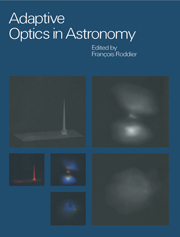Book contents
- Frontmatter
- Contents
- List of contributors
- Part one Introductory background
- Part two The design of an adaptive optics system
- Part three Adaptive optics with natural guide stars
- 8 The COME-ON/ADONIS systems
- 9 The UH–CFHT systems
- 10 Adaptive optics in solar astronomy
- Part four Adaptive optics with laser beacons
- Part five The impact of adaptive optics in astronomy
- Glossary of acronyms
- Index
8 - The COME-ON/ADONIS systems
from Part three - Adaptive optics with natural guide stars
Published online by Cambridge University Press: 23 November 2009
- Frontmatter
- Contents
- List of contributors
- Part one Introductory background
- Part two The design of an adaptive optics system
- Part three Adaptive optics with natural guide stars
- 8 The COME-ON/ADONIS systems
- 9 The UH–CFHT systems
- 10 Adaptive optics in solar astronomy
- Part four Adaptive optics with laser beacons
- Part five The impact of adaptive optics in astronomy
- Glossary of acronyms
- Index
Summary
Introduction to the COME-ON program
In the mid 1980s several programs were undertaken in astronomy to implement adaptive optics (AO) for visible (Doel et al. 1990; Acton and Smithson 1992) and infrared (IR) (Merkle and Léna 1986; Beckers et al. 1986) imaging. Those were stimulated by the coming new generation of very large telescopes of diameter D around 8 m (Barr 1986) and by the availability of AO components developed by defense programs (see for instance: Hardy et al. 1977; Pearson 1979; Gaffard et al. 1984; Fontanella 1985; Parenti 1988). Initiated by P. Léna, F. Merkle, and J.-C. Fontanella on the basis of the existing competences in France and at the European Southern Observatory (ESO), the COME-ON project was started in 1986 with the aim of demonstrating the performance of AO for astronomy. The consortium in charge of the project was initially made of three French laboratories associated with ESO, COME-ON standing for: CGE, a French company now CILAS (formerly LASERDOT), Observatoire de Paris-Meudon, ESO and ONERA. The purpose of the project was initially to build an AO-prototype system based on the available technologies and test it at an astronomical site, in order to gather experience for the ESO Very Large Telescope (VLT) program, including multi-telescope interferometry with the VLT interferometer (VLTI). The main requirement was to achieve nearly diffraction-limited imaging at the focus of a 4-m class telescope at near IR wavelengths from 2 to 5 μm, depending on the seeing conditions.
- Type
- Chapter
- Information
- Adaptive Optics in Astronomy , pp. 171 - 204Publisher: Cambridge University PressPrint publication year: 1999
- 4
- Cited by

